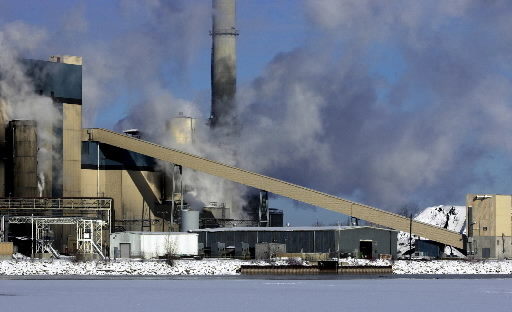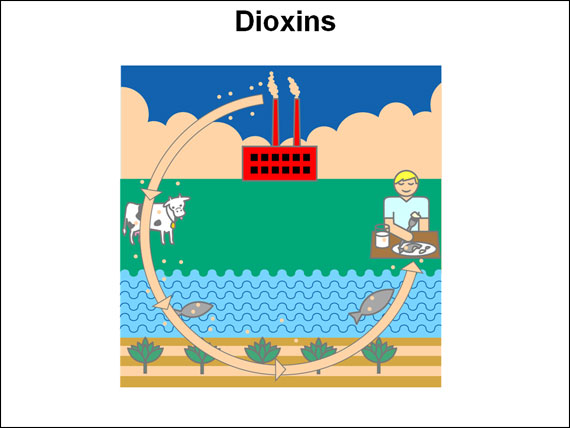Submitted by Rebekah Wilce on
 Koch Industries ranks in the "top ten" of the Toxic 100 list of the Political Economy Research Institute, which identifies the top U.S. air polluters among the world's largest corporations based on their chronic human health risk. Koch Industries is included in the list as the parent corporation of a diversity of industrial facilities that process and distribute fossil fuels, paper, wood products and synthetic fibers. The pollution from these facilities has a significant effect on the natural environment and on human health.
Koch Industries ranks in the "top ten" of the Toxic 100 list of the Political Economy Research Institute, which identifies the top U.S. air polluters among the world's largest corporations based on their chronic human health risk. Koch Industries is included in the list as the parent corporation of a diversity of industrial facilities that process and distribute fossil fuels, paper, wood products and synthetic fibers. The pollution from these facilities has a significant effect on the natural environment and on human health.
The Wisconsin Record
The Center for Media and Democracy decided to take a look at the record of Koch Industries here in Wisconsin where CMD is located. We examined the Toxics Release Inventory (TRI) compiled by the U.S. Environmental Protection Agency (EPA). Most industrial facilities are required to report toxic pollutant discharges to the air and to surface waterways to the EPA via the TRI program. The numbers companies report are for the most part unverified by the EPA and the discharges themselves are unmonitored, so the numbers reported are to some extent estimates based on certain calculations and assumptions.
Koch Industries operates twelve industrial facilities in Wisconsin: Georgia-Pacific and its wholly-owned subsidiaries in Green Bay (4 plants), Oshkosh, Phillips, and Sheboygan; and Flint Hills Resources in Green Bay, Junction City, McFarland, Milwaukee, Stevens Point and Waupun.
Dr. David Zaber, an eco-toxicologist, who was recently the Science Fellow at the Environmental Law and Policy Center in Chicago and the Director of Science at Defenders of Wildlife in Washington, D.C. before moving to Wisconsin, assisted the Center with a review of the most recent TRI data available from these facilities, for the years 2007, 2008, and 2009.
As Dr. Zaber notes, the TRI is "an underestimate of the total amount of toxic pollutants released to the environment because many facilities are exempt from reporting -- e.g. municipal sewage treatment plants, small discharges, etc. -- because they are either below relevant thresholds such as number of employees or otherwise not covered by TRI."
However incomplete, though, the data reveal that over the course of those three years, Koch Industries' facilities emitted over 5.4 million pounds (PDF)1 of toxic discharges into Wisconsin's air and water. Of these discharges, nearly 100,000 pounds (PDF) were of substances known or suspected to cause cancer.
Michael Ash, an Associate Professor of Economics and Public Policy at the University of Massachusetts Amherst and coauthor of the "Toxic 100 Air Polluters," says the numbers indicate that Koch Industries is a "major polluter" in Wisconsin. Rich Puchalsky, a TRI expert and a consultant for half a dozen environmental groups on TRI, concurs.
It's Raining Sulfuric Acid: #1 Worst Emitter of All Paper Facilities in Wisconsin
 From 2007-2009, TRI data shows that Koch Industries' facilities in Wisconsin released a total of 1.25 million pounds (PDF)2 of sulfuric acid, a major contributor to the formation of acid rain that, as an aerosol, causes respiratory tract irritation, especially to children and adults with asthma. Occupational exposure can cause cancer3 of the larynx. Koch Industries' Georgia-Pacific facility on Broadway Avenue in Green Bay was responsible for almost 23 percent (PDF)4 of the total discharges throughout the state in 2007-2009. The same Georgia-Pacific facility was the number one releaser of sulfuric acid of the six paper facilities in Wisconsin that reported the release of sulfuric acid to the EPA in 2009, disposing of 410,000 pounds of sulfuric acid on-site in that year. This was over 100 percent more than the total release of sulfuric acid of the next biggest polluter in the industry in the state.
From 2007-2009, TRI data shows that Koch Industries' facilities in Wisconsin released a total of 1.25 million pounds (PDF)2 of sulfuric acid, a major contributor to the formation of acid rain that, as an aerosol, causes respiratory tract irritation, especially to children and adults with asthma. Occupational exposure can cause cancer3 of the larynx. Koch Industries' Georgia-Pacific facility on Broadway Avenue in Green Bay was responsible for almost 23 percent (PDF)4 of the total discharges throughout the state in 2007-2009. The same Georgia-Pacific facility was the number one releaser of sulfuric acid of the six paper facilities in Wisconsin that reported the release of sulfuric acid to the EPA in 2009, disposing of 410,000 pounds of sulfuric acid on-site in that year. This was over 100 percent more than the total release of sulfuric acid of the next biggest polluter in the industry in the state.
According to the Georgia-Pacific website, "Wisconsin is the Number One paper manufacturing state in the United States." So, this Koch Industries' facility emitted the most sulfuric acid of any paper processor in the state that manufactures the most paper in the United States.
Koch Industries' two Georgia-Pacific facilities in Green Bay produce and distribute the following retail brands of paper products: Quilted Northern®, Vanity Fair®, Sparkle®, Mardi Gras®, Angel Soft®, Soft N' Gentle®, Brawny Industrial® and Dixie®.
Deadly Dioxins: #4 Worst Emitter of All Wisconsin Facilities
From 2007-2009, Koch Industries' facilities in Wisconsin released a total of over 5 grams (PDF)5 of dioxin and dioxin-like compounds (dioxins are usually measured in grams rather than pounds because they have a lower reporting threshold as persistent bioaccumulative compounds, meaning these substances can accumulate in the human body and the environment). Dioxins and dioxin-like compounds are toxic to humans and animals in multiple ways and are a known human carcinogen.6
 Even a small amount of dioxin can have a powerful impact. Dr. Zaber, who recently contributed to the Commission for Environmental Cooperation report Taking Stock: North American Pollutant Releases and Transfers and is an expert on toxic effects of chemical releases on wildlife, comments that "dioxins released in the Great Lakes basin are of particular concern because they persist in the environment and are passed up the food chain to humans through fish and other aquatic wildlife."
Even a small amount of dioxin can have a powerful impact. Dr. Zaber, who recently contributed to the Commission for Environmental Cooperation report Taking Stock: North American Pollutant Releases and Transfers and is an expert on toxic effects of chemical releases on wildlife, comments that "dioxins released in the Great Lakes basin are of particular concern because they persist in the environment and are passed up the food chain to humans through fish and other aquatic wildlife."
In 1997, the United States and Canada jointly developed the Great Lakes Binational Toxics Strategy (BTS) committing to quantified reductions in the amount of contaminants released into the environment. Dioxins are what is known as a "Level I" persistent toxic substance targeted to be "substantially reduced" because of its hazards to humans and our ecosystem.
And yet, a decade and more after the BTS was developed and implemented, Koch Industries' Georgia-Pacific facility on Broadway Avenue in Green Bay emitted more dioxins on-site than any of the 17 paper facilities emitting dioxins in Wisconsin in 2007. In 2009, it ranked second highest in dioxin emissions out of 14 total facilities in Wisconsin.
Nickel Compounds: #1 Worst Emitter of All Wisconsin Facilities
From 2007-2009, TRI data show that Koch Industries in Wisconsin released 9,780 pounds (PDF)7 of nickel compounds. Nickel is a heavy metal, and nickel compounds are a known human carcinogen (PDF)8 and cause other adverse effects on respiratory function. An important review of studies on heavy metal poisoning commissioned by the National Water Research Institute, entitled "A silent epidemic of environmental metal poisoning?" (PDF) emphasized that "as a global problem, the potential health effects of metallic hazards should be a matter of public health concern, especially if the emissions of toxic metals into the environment continue at the current rate... . [M]etals that can adversely affect human reproduction include As, Sb, Be, Cd, Hg, Cr, Co, Ni and Al" (arsenic, antimony, beryllium, cadmium, mercury, chromium, cobalt, nickel and aluminum). "These elements are… released in large quantities into the environment and may be contributing to the reproductive failures being experienced by contemporary populations."9
In 2007, Koch Industries' Georgia-Pacific facility on Broadway Avenue in Green Bay emitted more nickel than any other of the 32 industrial facilities reporting nickel discharges to the air and/or water. Of a total statewide discharge of 6,645 pounds, the Georgia-Pacific facility emitted 3,410 pounds, or 51 percent, greater than all the other discharges of other facilities combined. In 2009, the same Georgia-Pacific facility was the only paper facility in Wisconsin to report the release of any nickel or nickel compounds to the EPA, at a total of 3,260 pounds of nickel compounds. Of that amount, almost all of it (3,160 pounds) was emitted directly to the air or water, again leading all 38 of the reporting industrial facilities in the state.
Cancer-Causing Benzene: Koch's Subsidiary Was One of Top Ten Worst Emitters of All Wisconsin Facilities
From 2007-2009, TRI data show that Koch Industries' facilities in Wisconsin released a total of 5,546 pounds (PDF)11 of benzene, which is a known human carcinogen12 and causes other serious adverse human health effects. In 2009, discharges of benzene from Koch Industries' Flint Hills Resources facilities in Milwaukee, McFarland, and Junction City were ranked 6th, 7th, and 9th, respectively, out of 20 industrial facilities in Wisconsin that reported benzene releases to the EPA.
Conclusion
This data demonstrates that Koch Industries generates significant pollution in Wisconsin. It is important to keep in mind that the TRI data are self-reported and do not cover all discharges in an area or to a watershed. Nor does this information indicate all of the possible effects of all the possible mixtures of chemicals that could occur with these discharges and the resultant risks to ecosystems as well as to reproductive health or other effects on disease or lifespans of people in the state and region.
According to Dr. Zaber, "It is expected for industrial facilities to generate some toxic emissions. However, at a time when good technology exists to reduce pollution, when operating in a place as environmentally sensitive as the Great Lakes basin, and at the scale of a conglomerate as large as Koch Industries, what comes out of their stacks and pipes has a lasting impact on Wisconsin." Plainly, further examination of the impact of Koch Industries in Wisconsin and elsewhere is warranted.
Notes
1. EPA Toxics Release Inventory data analyzed by Dr. David Zaber for the Center for Media and Democracy (PDF), March 21, 2011.
2. EPA TRI data analyzed by Dr. David Zaber for the Center for Media and Democracy (PDF), March 21, 2011.
3. Centers for Disease Control and Prevention (CDC), Agency for Toxic Substances and Disease Registry (ATSDR), ToxFAQs™ for Sulfur Trioxide and Sulfuric Acid (PDF), 1999, p. 2.
4. Georgia-Pacific's Broadway facility in Green Bay produced 1.25 million pounds of sulfuric acid from 2007-2009, while total facilities in Wisconsin combined produced 5.46 million pounds, as shown in these EPA TRI data (PDF) analyzed by the Center for Media and Democracy, May 19, 2011.
5. Georgia-Pacific's Broadway facility in Green Bay produced 5.1105 grams of dioxins from 2007-2009, as shown in these EPA [https://www.sourcewatch.org/images/2/21/Wisconsin_Dioxins_2007-2009.pdf TRI data (PDF)] analyzed by the Center for Media and Democracy, May 19, 2011.
6. CDC, ATSDR, Public Health Statement for Chlorinated Dibenzo-p-dioxins (CDDs) (PDF), 1998, p. 8.
7. EPA TRI data analyzed by Dr. David Zaber for the Center for Media and Democracy (PDF), March 21, 2011.
8. Department of Health and Human Services (DHHS), National Toxicology Program (NTP), “Substance Profiles: Nickel Compounds and Metallic Nickel (PDF),” Report on Carcinogens (RoC) 11th Edition, p. 1.
9. J.O. Nriagu, “A silent epidemic of environmental metal poisoning?” (PDF) Environmental Pollution 50(1-2) (Barking, Essex: 1988), pp. 139 & 153.
10. EPA TRI data analyzed by Dr. David Zaber for the Center for Media and Democracy (PDF), March 21, 2011.
11. CDC, ATSDR, ToxFAQs™ for Benzene (PDF), 2007, p. 2.
